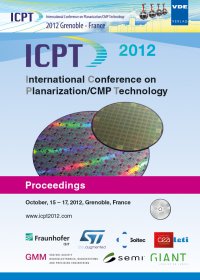Slurry Abrasive Particle Agglomeration Experimentation and Modeling for Chemical Mechanical Planarization (CMP)
Conference: ICPT 2012 - International Conference on Planarization / CMP Technology
10/15/2012 - 10/17/2012 at Grenoble, France
Proceedings: ICPT 2012
Pages: 6Language: englishTyp: PDF
Personal VDE Members are entitled to a 10% discount on this title
Authors:
Johnson, Joy M.; Boning, Duane S. (Massachusetts Institute of Technology, Cambridge, MA, USA)
Kim, Gwang-Soo; Safier, Paul; Knutson, Karson (Intel Corporation, Hillsboro, OR, USA)
Abstract:
Prior work has established a theoretical basis upon which one can model the colloidal behavior of silica CMP slurry abrasive particles, without the use of extensive experimental data fitting, from measurable chemical and physical parameters of their slurry composition [1]. In an attempt to understand the disparity in published and replicated empirical data in the CMP community [1, 2, 3, 4], prior work suggested that a distinct mechanism dominatinges the creation of silica abrasive particle agglomerates under high shear. This silica-specific mechanism is the formation of interparticle siloxane bonds from silanoldissociated acid-base bonds, the creation of which is not adequately modeled by the classical DVLO colloidal stability theory traditionally used to model oxide particles in aqueous suspensions [5, 6]. In the colloidal and interface science (CIS) community, there is an abundance of accepted experimental evidence of this divergence of colloidal silica from classical DVLO theory with its maximum stability around its isoelectric point, in the absence of shear [6, 7, 8, 9, 10]. Yet, there currently is no accepted theoretical model, either an extension of DVLO theory, nor a novel silica-specific surface interaction energy model, under high shear.


